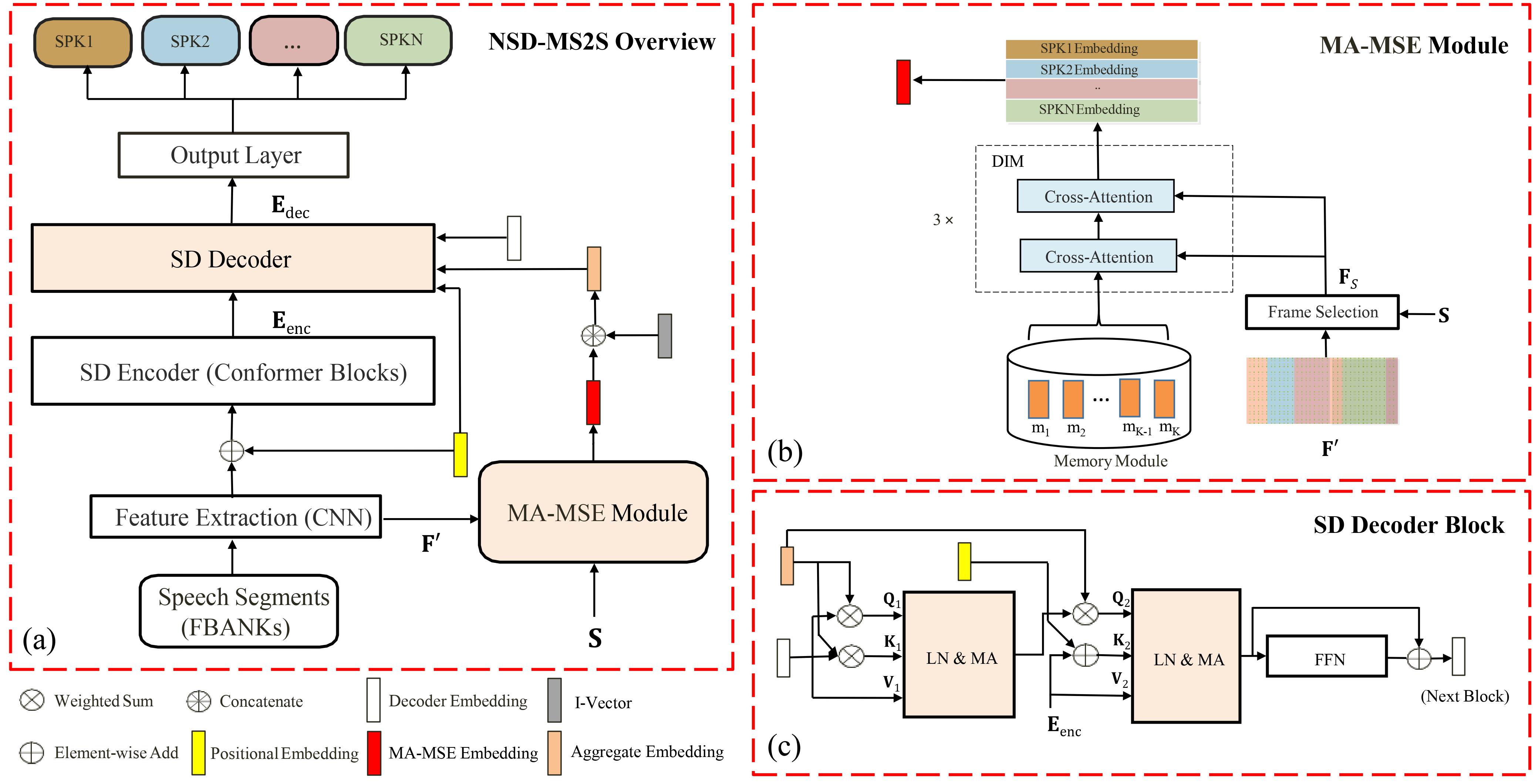This repository is an official pytorch implementation of the paper "Neural Speaker Diarization Using Memory-Aware Multi-Speaker Embedding with Sequence-to-Sequence Architecture", for more details please see paper. Our previous work NSD-MA-MSE can be found in this repository, if your training data is not particularly adequate, please prioritize NSD-MA-MSE, it usually leads to better results in our experience. Have fun!

pip install -r requirements.txt#local/model_S2S_weight_input_DIM.py
from model_S2S_weight_input_DIM import MULTI_MAM_SE_S2S_model
from config import configs3_4Speakers_ivector_ivector128_xvectors128_S2S_MA_MSE_DIM as config_train
net = MULTI_MAM_SE_S2S_model(config_train).cuda()
B = 16
data = torch.randn(B, 40, 800).cuda() # B, F, T
overall_embedding = torch.randn(B, 4, 100).cuda() # B, N, D1
mask = torch.randint(0, 2, size=(B, 4, 800), dtype=torch.int).cuda() # B, N, T
with torch.no_grad():
out = net(data, overall_embedding, mask)
print(out.shape) # B, N, T
- Data simulation
We generated simulated data by https://github.com/jsalt2020-asrdiar/jsalt2020_simulate for CHiME-7 DASR Challenge, for more details please see our tech report paper.
- Extract fbank
You should use local/extract_feature.sh to extract fbanks and i-vector for training. For example:
local/extract_feature.sh --stage 1 --nj $nj \
--sample_rate _16k --ivector_dir $ivector_dir \
--max_speaker 4 --affix _$affix \
--rttm data/$data/diarized.all.rttm --data $data
- After preparing the training data in the format needed for the local/run_MAMSE_S2S_chime7_ws_input_DIM.py, e.g.
#local/run_MAMSE_S2S_chime7_ws_input_DIM.py
data="CHiME6MAMSELabel_SimuCHiME6_Mixer6MAMSELabel_SimuMixer6_SimuDipcoDevNoise" # train data name
feature_scp = f"data/{data}/cmn_slide_fbank_htk.list" # your fbanks list
ivector_path = f"data/{data}/ivectors_spk.txt" # your i-vector path
oracle_rttm = f"data/{data}/oracle.rttm" # your oracle.rttm path
Then simply execute the following command:
# 8 GPUs
python -m torch.distributed.launch --nproc_per_node=8 local/run_MAMSE_S2S_chime7_ws_input_DIM.py
You can check the decoding results with the following decode commands (Case4 below):
# single model decode, it might be a little better compared to the results of the paper.
bash local/decode_S2S_model.sh --stage 3 --data chime7_eval_all_CH --diarized_rttm data/chime7_eval_all_CH/f1.rttm --affix f1
# models fusion decode, there are no results here, just as an example
bash local/decode_S2S_models_fusion.sh --stage 3 --data chime7_eval_all_CH --diarized_rttm data/chime7_eval_all_CH/f1.rttm --affix f1
Other usage:
-
Case1:
- local/decode_S2S_model.sh --stage 1 && local/extract_feature.sh --stage 1 (modified in decode_S2S_model.sh stage 1) indicates the first time you decode one dataset, including generating fbanks for this dataset and extracting the i-vector based on the provided rttm (use clustering or other methods to get), and then decoding it.
-
Case2:
- local/decode_S2S_model.sh --stage 1 && local/extract_feature.sh --stage 3 (modified in decode_S2S_model.sh stage 1) indicates that you have extracted the fbanks and now have a new initialization rttm to extract the new i-vector and re-decode the dataset.
-
Case3:
- local/decode_S2S_model.sh --stage 2 denotes the re-decoding based on the existing fbank and i-vector.
-
Case4:
- local/decode_S2S_model.sh --stage 3 indicates that decoding is complete, re-check the decoding result.
Models fusion decoding script (decode_S2S_models_fusion.sh) have similar usage.
If you find this code useful in your research, please consider to cite the following papers:
@article{yang2023neural,
title={Neural Speaker Diarization Using Memory-Aware Multi-Speaker Embedding with Sequence-to-Sequence Architecture},
author={Yang, Gaobin and He, Maokui and Niu, Shutong and Wang, Ruoyu and Yue, Yanyan and Qian, Shuangqing and Wu, Shilong and Du, Jun and Lee, Chin-Hui},
journal={arXiv preprint arXiv:2309.09180},
year={2023}
}
@ARTICLE{10093997,
author={He, Mao-Kui and Du, Jun and Liu, Qing-Feng and Lee, Chin-Hui},
journal={IEEE/ACM Transactions on Audio, Speech, and Language Processing},
title={ANSD-MA-MSE: Adaptive Neural Speaker Diarization Using Memory-Aware Multi-Speaker Embedding},
year={2023},
volume={31},
number={},
pages={1561-1573},
doi={10.1109/TASLP.2023.3265199}}
@inproceedings{seq2seq,
title={{Target-Speaker Voice Activity Detection via Sequence-to-Sequence Prediction}},
author={Cheng, Ming and Wang, Weiqing and Zhang, Yucong and Qin, Xiaoyi and Li, Ming},
booktitle={ICASSP 2023-2023 IEEE International Conference on Acoustics, Speech and Signal Processing (ICASSP)},
pages={1-5},
year={2023},
organization={IEEE}
}